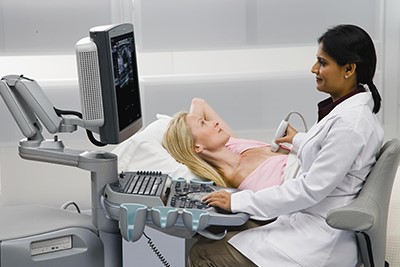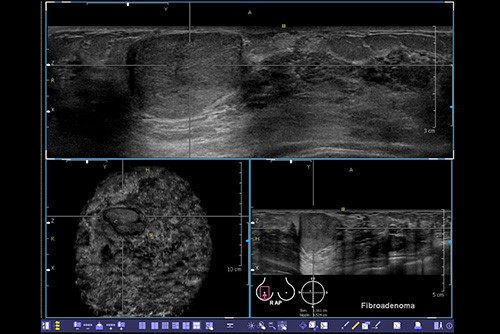
Breast Ultrasound uses a handheld transducer that transmits high-frequency sound waves into the body and translates the returning waves into images, which your radiologist interprets to identify tumors in dense breast tissue.
PINK Breast Center uses the latest technology designed to detect breast cancer. Patients rely on PINK for State-of-the-art equipment and technologists with advanced training in breast ultrasound. PINK also offers breast ultrasound with elastography for more advanced screenings and cancer detection.
Breast Ultrasound Explained
A breast ultrasound uses high-frequency sound waves to look inside your breast to detect cancers, cysts, or masses. An ultrasound technician uses a sound-emitting probe to conduct the test. The sound waves travel through the breast, and then they are converted into images on a screen. The ultrasound exam can demonstrate whether a lump is a solid or a liquid filled mass such as a cyst, leading to different treatments. Consistent with studies that show having a breast ultrasound with an annual mammogram can find more small cancers than a mammogram alone, a high percentage of the cancers PINK finds are found with ultrasound.
Elastography
Elastography is a non-invasive technology projecting ultrasound waves into your breast to characterize cysts vs. other masses in the tissue. Cysts are composed of fluid and do not require the same treatment as other masses. If the mass is solid, and potentially cancer, it will appear stiff compared to surrounding tissue.
When to Get a Breast Ultrasound
Women with dense breast tissue or scattered breast density benefit from breast ultrasound examinations. Dense tissue decreases the sensitivity of mammography, making it difficult for the radiologist to find cancers that are “hidden” behind dense breast tissue. Breast density is not based on the way that your breast feels, but how much connective tissue appears in comparison to the amount of fatty tissue. Connective or dense tissue can appear as a lump that may not be visible on a mammogram.
If a woman under the age of 30 has a palpable breast lump, she may receive an ultrasound before considering a mammogram. In younger women, a mammogram may be hard to interpret because of breast density caused by milk glands.
The New Jersey Breast Cancer Screening Mandate requires insurance companies to cover breast ultrasound screenings for women with dense breast tissue.
Schedule an Appointment
PINK Breast Center offers all types of ultrasound. For more information on general and breast ultrasounds, contact us today.

